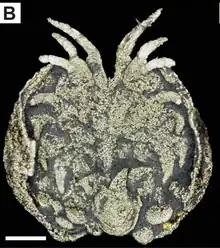| Luprisca Temporal range: Ordovician, | |
|---|---|
 | |
| Fossil specimen | |
| Scientific classification | |
| Kingdom: | |
| Phylum: | |
| Subphylum: | |
| Order: | |
| Genus: | Luprisca Siveter et al., 2014 |
| Species: | L. incuba |
| Binomial name | |
| Luprisca incuba Siveter et al, 2014 | |
Luprisca incuba is an extinct species of ostracod crustacean.[1] It was described as a new species in 2014, following discovery and analysis of fossilized specimens in mudstone rocks from New York, United States. A team of researchers from the universities of Yale and Kansas, Oxford and the Japan Agency of Marine Science and Technology made the discovery.[2]
Etymology
The genus and species name were named after Lucina, the goddess of childbirth in Roman mythology, and incuba, implying the mother was incubating her eggs.[1]
Description
With 1.2 to 2.5 millimetres (0.047 to 0.098 in) long carapace, it is suggested that the animal was intact with a shell along with the delicate parts of limbs and embryos within the shell. The fossil was preserved in pyrite and was examined using X-Ray and CT Scan techniques.[1]
Habitat and behavior
This species was discovered in the mudstone rocks from New York State, from a rock layer called the Lorraine Group. The discovery was said to be the earliest evidence for parental care in the fossils of ostracod. Although some reported this discovery as "oldest parenting of fossil record",[3] however some Cambrian fossil records with brood care, like Waptia are known.[4]
“The mother kept the eggs and the hatchlings in brooding pouches within her body until the young ones were big enough to go out on their own,” David Siveter, professor of geology at the University of Leicester [5] in the UK who led the study, told The Telegraph India. A research paper by Siveter and his colleagues describing the ostracod fossils was published in the journal Current Biology.[1]
References
- 1 2 3 4 Siveter, David J.; Tanaka, Gengo; Farrell, Úna C.; Martin, Markus J.; Siveter, Derek J.; Briggs, Derek E.G. (2014). "Exceptionally Preserved 450-Million-Year-Old Ordovician Ostracods with Brood Care". Current Biology. 24 (7): 801–806. doi:10.1016/j.cub.2014.02.040. PMID 24631241.
- ↑ "Fossil discovery unearths 'nursery in the sea' - Technology & Science - CBC News". cbc.ca. Retrieved 2014-03-15.
- ↑ "Researchers uncover oldest sign of parenting in Earth's fossil record". The University of Kansas. 2014-03-25. Retrieved 2022-11-06.
- ↑ Caron, Jean-Bernard; Vannier, Jean (2016-01-11). "Waptia and the Diversification of Brood Care in Early Arthropods". Current Biology. 26 (1): 69–74. doi:10.1016/j.cub.2015.11.006. ISSN 0960-9822. PMID 26711492. S2CID 10182506.
- ↑ "Professor David Siveter — University of Leicester". www2.le.ac.uk. Retrieved 2014-03-15.